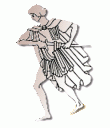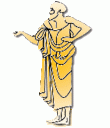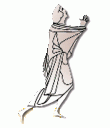Page 2
(The Study of Threes)
http://threesology.org
This third list is something I found on the internet years ago when I began to place various examples onto webpages. It too is compiled on another of the pages at this site under a different heading: Threesological page 5.
Triple structure examples by Alexander I. Stepanov:
- persons of pronouns: I - You - (he - she - it);
- genders: masculine - feminine - neuter;
- past - present - future;
- three part's division of time by Confucius, Zoroastrians;
- the tense system in German;
- degrees of comparison for adjectives and adverbs: positive - comparative - superlative;
- articles: definite - indefinite - zero;
- parts of the sentence: two primes and a secondary;
- the Heaven - the Earth - the Hell (Paradise - Earth - Inferno);
- body - soul - spirit;
- geosphere - biosphere - noosphere;
- mind - sense - will;
- three levels of the ego by K. Jaspers; more - less - equal;
- rational quantities - algebraic irrational ones - transcendence;
- real numbers - complex numbers - quaternions;
- rich - middle - poor classes in modern Western societies;
- the nobility - the clergy - the third estate in absolutistic France;
- poetic social order in The Republic by Plato;
- estate order in the Russian empire;
- three forms of state service: military - civilian - court;
- three branches of state power: legislative - executive - judicial;
- the institute of tripartite commissions: business - trade unions - government;
- the court: prosecution - defense - judge;
- the forms of government: autocracy - oligarchy - democracy;
- types of legal power by M. Weber;
Standard classification of political movements (and variants):
liberalism - conservatism - radicalism
liberalism - conservatism - Marxism;
liberalism - Marxism - nationalism;
the Right - the Left - the Centre;
- the West - the East - the Third World;
- the notion of "the Third Way";
- world-system analysis: kernel - semi-periphery - periphery;
- Russian ideology of the 19th century: orthodoxy - autocracy - nationality;
- state ideology of Thailand: nation - religion - monarchy;
- A. Ferguson: Ages of savagery - barbarism - civilization;
- Thomsen: the Stone - the Bronze - the Iron Ages;
- palaeolithic period - mesolithic period- New Stone Age;
- Ancient history - Middle Ages - Modern times;
- "Moscow is the Third Rome";
- "the Third Reich" (Adolf Hitler);
- "the Third Revelation";
- classical system of literary genre: lyrics - epos - drama;
tragedy - comedy - drama; - literary process: author - reader - critic;
- ingredients of aesthetic object by M.M. Bakhtin: author - hero - audience;
- Frege's triangle: real object - concept - symbol (denotation - designation - name);
- F. de Saussure: langage - langue - parole
- (Germ.: Rede - Sprache - das Sprechen or Sprache - Sprachtum - Sprechart);
- mental structure of a person by S. Freud: the subconscious - consciousness - Super ego;
- faith - hope - love;
- spheres of moral law by Thomas Aquinas: the natural realm of elements - the heavenly world of the firmament - intelligible world;
- the threes by J. Boehme;
- the truth - the good - the beauty;
- the highest cognitive abilities by I. Kant: reason - intellect - the ability for judgment;
Hegel:
- the universal - the particular - the single,
- being - nothing - becoming;
- quality - quantity - measure;
- essence - phenomenon - reality,
- law - ethics - morals,
- the family - the guild - the state,
- thesis - antithesis - synthesis;
- the life styles by S.A. Kierkegaard: aesthetic - ethic - religious;
- three main paradigms of New Age's philosophy by A. Whitehead: idealism - materialism - dualism;
- races of mankind: the three-race theory (Negroid - Mongoloid - Caucasoid);
- ethnic kernel of American nation: the English - the Germans - the Irish;
- main groups of European nations: Romanic - Germanic - Slavonic;
- pivotal world religions: Christianity - Islam - Buddhism;
- three main parts of Christianity: Catholicism - Orthodoxy - Protestantism;
- key religious and philosophical components of the traditional Chinese culture: Confucianism - Daoism - Buddhism;
- the threes of folklore's heroes;
- Pythagorean classification of living intelligent creatures: God - man - a creature like Pythagoras;
- Pascal: "The God of Abraham, Isaac, Jacob, but not the God of philosophers";
- Roman law: tres facuint collegium (the three make a collegium);
- number three by the Pre-Iranians, Chinese, primordial people;
- the structure of monogamic family: man - wife - children;
- three-dimensional physical space;
This next list was information taken from a poster: Aristotle's Golden Mean Chart. While the information is not typically presented under the heading of Trichotomies, it clearly is.
| Sphere of action or feeling |
 + Excess (fight) |
 ←→ Mean (Submit) |
 - Defeciency (Flight) |
| Fear and Confidence | Rashness thrasutes |
Courage andreia | Cowardice deilia |
| Pleasure and Pain | Licentiousness akolasia | Temperance sophrosune | Insensibility anaisthesia |
| Getting and Spending (minor) | Prodigality asotia |
Liberality eleutheriotes | Illiberality / Meanness aneleutheria |
| Getting and Spending (major) | Vulgarity apeirokalia, banausia | Magniicence megaloprepeia |
Pettiness mikroprepeia |
| Honor and Dishonor (Major) | Vanity chaunotes |
Magnanimity megalopsuchia | Pusillanimity mikropsuchia |
| Honor and Dishoner (Minor) | Ambition philotimia |
Proper ambition ... | Unambitiousness aphilotimia |
| Anger | Irascibility orgilotes | Patience praotes |
Lack of spirit aorgesia |
| Self-expression | Boastfulness alazoneia |
Truthfulness aletheia | Understatement eironeia |
| Conversation | Bufoonery bomolochia |
Wittiness eutrapelia | Boorishness agroikia |
| Social conduct | Obsequiousness areskeia Flattery kolakeia |
Friendliness philia (?) | Cantankerousness duskolia (duseris) |
| Shame | Shyness kateplexis | Modesty aidos |
Shamelessness anaischuntia |
| Indignation | Envy phthonos | Righteous indignation nemesis | Malicious enjoyment epichairekakia |
Chart based on: Aristotle. he Nicomachean Ethics (Penguin Classics). Ed. Hugh Tredennick. Trans. J. A. K. homson. New York: Penguin Classics, 2003. pp. 285-286. Illustration of rashness, courage, and cowardice modiied from: Baird, Forrest E. Ancient Philosophy (Philosophic Classics, Volume I--4th Edition). Upper Saddle River: Prentice Hall, 2002.
Page initially created: Monday, April 28, 2014
Herb O. Buckland
herbobuckland@hotmail.com